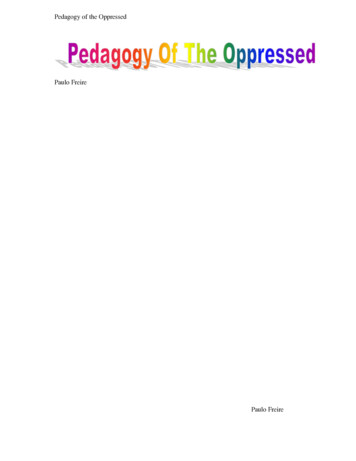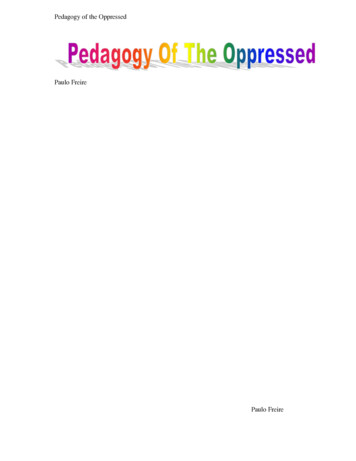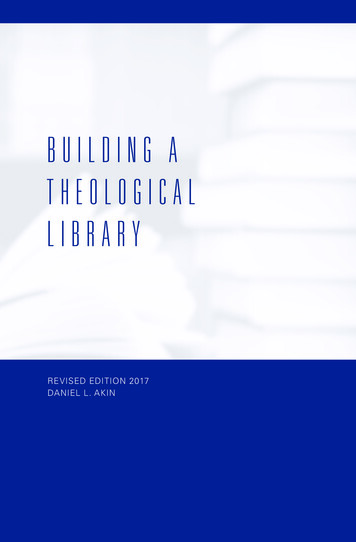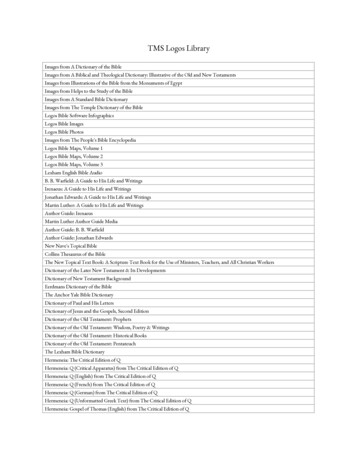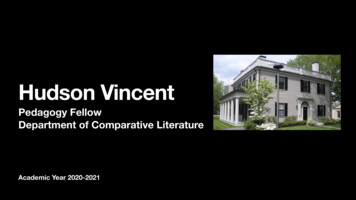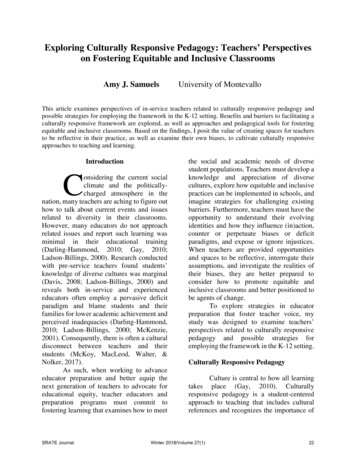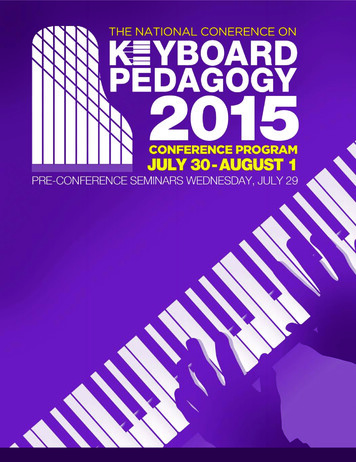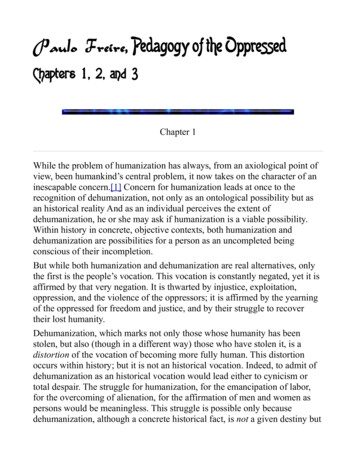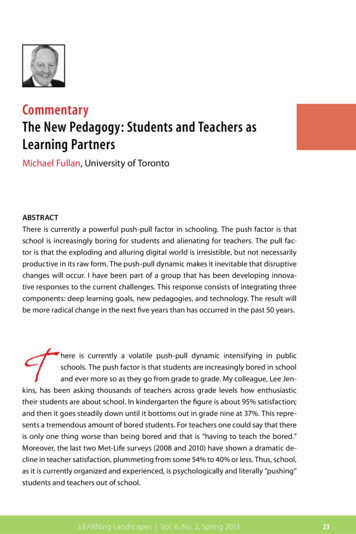
Transcription
CommentaryThe New Pedagogy: Students and Teachers asLearning PartnersMichael Fullan, University of TorontoABSTRACTThere is currently a powerful push-pull factor in schooling. The push factor is thatschool is increasingly boring for students and alienating for teachers. The pull factor is that the exploding and alluring digital world is irresistible, but not necessarilyproductive in its raw form. The push-pull dynamic makes it inevitable that disruptivechanges will occur. I have been part of a group that has been developing innovative responses to the current challenges. This response consists of integrating threecomponents: deep learning goals, new pedagogies, and technology. The result willbe more radical change in the next five years than has occurred in the past 50 years.There is currently a volatile push-pull dynamic intensifying in publicschools. The push factor is that students are increasingly bored in schooland ever more so as they go from grade to grade. My colleague, Lee Jenkins, has been asking thousands of teachers across grade levels how enthusiastictheir students are about school. In kindergarten the figure is about 95% satisfaction;and then it goes steadily down until it bottoms out in grade nine at 37%. This represents a tremendous amount of bored students. For teachers one could say that thereis only one thing worse than being bored and that is “having to teach the bored.”Moreover, the last two Met-Life surveys (2008 and 2010) have shown a dramatic decline in teacher satisfaction, plummeting from some 54% to 40% or less. Thus, school,as it is currently organized and experienced, is psychologically and literally “pushing”students and teachers out of school.LEARNing Landscapes Vol. 6, No. 2, Spring 201323
Michael FullanAt the same time the digital world of learning and entertainment is exploding, most of it outside schooling. Explosion is the word. What is becoming availableis enormous, and easy to access. The pull here is incredibly irresistible, but not necessarily productive in the sense that it is largely ungoverned. Given the push-pull tension we need to avoid either of two extreme reactions. One counterproductive moveis to try to rein in students—not a chance against the allure of technology. Anotheris to marginalize teachers on the grounds that technology can replace them. This toowould be a mistake, as mere immersion in the land of information does not makeone smarter.So we are left with a fundamental problem: the dynamic push-pull phenomenon is rapidly reaching a breaking point. Enter the “new pedagogy.” In mybook, Stratosphere I suggested that the learning solution would have to meet fourcriteria. They must be:i)ii)iii)iv)Irresistibly engaging for both students and teachersElegantly efficient and easy to access and useTechnologically ubiquitous 24/7Steeped in real-life problem solving (Fullan, 2013a)This new engagement is in pursuit of “deep learning goals,” which we havereferred to as the 6cs: critical thinking and problem solving; communication; collaboration; creative thinking and imagination; character education; and citizenship (Fullan, 2013b). It is clear that schooling would have to be radically overhauled to meetthe four criteria above and to enable learning to flourish.The New PedagogyThere are fundamental structural and policy matters to be considered inrelation to standards, assessment, governance, and organization of schooling. In thisbrief paper I want to indicate the starting point—what we call “the new pedagogy.”By definition we only have a preliminary directional notion of what it might look like.In fact I am working with a group of partners to help map out this task.1 Here we justsee the beginning point that can be stated in the following paragraphs.The basic notion is teachers and students as learning partners. We getan inkling of this in one of the clusters that John Hattie (2012) compared from his24LEARNing Landscapes Vol. 6, No. 2, Spring 2013
The New Pedagogy: Students and Teachers as Learning Partnersmeta-analysis of over 1000 research studies. At one point he combines certaininstructional practices as “teacher as facilitator,” and as “teacher as activator,” andshows their “effect sizes.” He suggests that effect sizes less than .40 are not worthconsidering, and those above .40 are of increasing interest. This is what he found:Teacher as Facilitator (.17 effect): simulations and gaming; inquiry based;smaller class sizes; individualized instruction; problem-based learning; web-bases;inductive teachingTeacher as Activator (.60 effect size): reciprocal teaching; feedback; teacherstudent self-verbalization; meta-cognition; goals challenging; frequent checks oneffects of teachingThese findings are provocative and raise several critical questions concerning the new pedagogy. First, they say to me that the reason that the first cluster hadsuch a weak impact is that they were used so to speak “poorly pedagogically.” Putanother way, the guide on the side is a poor pedagogue; or we don’t want “a guide onthe side” anymore than we need a “sage on the stage.” More proactive partnershipwill be required.Second, it is not clear exactly what the new pedagogy would look like. Ingeneral terms I would take it as teacher as “change agent or activator,” and studentas proactive partner in learning. Not only would this require radically new learningrelationships between students and teachers, but also among them. The next step,and that is what we are working on, is to map out what this new learning relationshipwould look like—what it is, and why it would be good for learning.Third, how can this new learning relationship be developed in a way that itpositively affects deep learning goals, such as the 6Cs cited above.Fourth, Hattie did not even examine the possible role of technology. Twoitems on his list are simulations/gaming and web-based. They were both in the weakimpact category. I would surmise that the main reason is that they were used passively as the teacher as guide on the side. The new question by contrast is, with astrong teacher-learner partnership, how could technology be used to deepen andaccelerate learning.Fifth, and finally, what about the implications for costs. The per-pupil costof education in the current model is breaking the bank; and when you look closelyLEARNing Landscapes Vol. 6, No. 2, Spring 201325
Michael Fullanit is inefficient as well as ineffective. I had a throwaway line in my book that said,“welcome to the stratosphere where you get twice the learning for half the cost.” Thisnow seems to be an underestimation of the cost of running the new pedagogy. Takethree obvious time and cost savers that could come together. One, to put it crassly,is student labor—in the new system students help teachers with technology; theyhelp other students as tutors and co-learners; and they help themselves throughtaking on a greater share of learning as partners. None of this costs a single penny.Also, because the new pedagogy harnesses learning resources 24/7, the learning dayis effectively doubled or more. Lastly, technology can achieve new efficiencies as itreaches more learners, more easily just as the MOOCs2 are doing in higher education.All in all the new system will be cheaper, easier, deeper, and more engaging.Taken together these five implications represent a new learning agendathat is as exciting as it is daunting. This work will draw new energy that will expandgeometrically as it feeds on itself. This is what Clayton Christensen means by “disruptive innovations.”3 The scenario is this: the status quo is beginning to reach thelimits of its yield (the push factor above); people still are committed to continuousimprovement of the existing system (albeit with marginal results); along comes disruptive innovations (e.g., digital product); these early versions, to use Christensen’scritical observation, are “inferior products” (compared at this early stage to existingversions); and what ensues is a “rapid learning cycle” where innovations are tried,discarded, refined, and ever improving.Future Directions and ConsiderationsThe question for the field of education is how it can best participate in thisrapid learning cycle while working in an otherwise less and less functional system.The general conclusion for me is that this will be a messy period in which the beststance is to become a reflective doer and learner. One way of cutting this is to thinkof working simultaneously on continuous improvement and on innovation. In the“Great to Excellent” paper (Fullan, 2013b), I recommended that Ontario “continue”to go deeper in improving literacy, mathematics, and high school graduation, whileit simultaneously engaged in “focused innovation” in relation to the 6Cs, and toearly learning.Relative to the 6Cs we need to shift from the perennial superficial homageto the 21st century learning skills, that has been going on for at least a quarter of a26LEARNing Landscapes Vol. 6, No. 2, Spring 2013
The New Pedagogy: Students and Teachers as Learning Partnerscentury, to the development of what it means to actually implement them in practice.This will entail the hard operational work of defining what each of the skills actuallymeans (and their interrelationships), identifying and developing what learning wouldactually look like, and assessing the learning outcomes therein. This is of course thenew pedagogy agenda.Similar detailed work will have to be carried out relative to early learning. Thecritical importance of early learning—prenatal to age five—has also been known fora long time. For more than a quarter of century we have known that careful attentionto the early years will pay off economically at least seven times the investment, notto mention the myriad benefits for individuals and society that will accrue. In Ontariowe are implementing full-day kindergarten (FDK) for all four and five year olds in theprovince. There are some 250,000 children in question. Half of them are being currently served with the remaining 50% to be incorporated in 2013 and 2014. Focusedinnovation does not just pertain to structure and capital, or to getting the educationforce in place (early childhood staff and teachers), but also to the everyday learning curriculum and assessment. In operational terms, what does “play-based inquirylook like,” what does it accomplish, and how does it feed forward to grades one andbeyond. This is of course part and parcel of the evolution of the 6Cs curriculum.From a change perspective we have to work at both the micro and macrolevels and their interconnections. At the micro level the watchwords for the new pedagogy are precision, specificity, and clarity. We have to develop in practice what thisnew work looks like, not in order to prescribe it, but to know what it means and to beclearer about how to do it, assess it, and learn from it.The macro level involves what we have been working on since 1997—whatcan be called “whole system change” (WSC). The content of WSC is beyond the termsof reference of this paper. Two things can be said briefly here. One is that we knowa good deal about how to improve the whole system in terms of raising the bar andreducing the gap for all students, which includes factors such as: a relentless focuson a small number of ambitious goals; a positive non-punitive stance toward the sector that places accountability more in the position of being a motivator; transparency of results and practice including the use of data for improvement, and for public accountability; ongoing investment in capacity building (professional learning);learning from implementation across the system; the development of an infrastructure and related fostering of leadership on all levels; and a general sense of verticaland horizontal partnership committed to immediate and continuous improvement.LEARNing Landscapes Vol. 6, No. 2, Spring 201327
Michael FullanThe second thing that can be said is that no system in the world has developed such an infrastructure as we have just described that was developed to stimulate and serve the kind of innovative teaching and learning that I am portraying inthis paper.In short, we have our work cut out for ourselves. At the same time the direction and nature of the change is reasonably clear, while the development and implementation of solutions is as exciting as it is daunting. What could be a better learningproposition—high risk, high yield in the context of an unavoidable challenge.Notes1.See Partnership for New Pedagogies for Deep Learning, including the M. Fullanand M. Langworthy White Paper, http://www.newpedagogies.org/, as well as M.Fullan and K. Donnelly, Alive in the Swamp, Assessing Digital Innovations in Educa tion. London: NESTA; and Oakland, CA: NewSchools Venture Fund.2.Massive Open Online Courses3.Please see: erencesFullan, M. (2013a). Stratosphere: Integrating tech nology, pedagogy, and change knowledge.Toronto: Pearson.Hattie, J. (2012). Visible learning for teachers.London: Routledge.Fullan, M. (2013b). Great to excellent: Launching the next stage of Ontario’s educationagenda. Retrieved from 28LEARNing Landscapes Vol. 6, No. 2, Spring 2013
The New Pedagogy: Students and Teachers as Learning PartnersMichael Fullanis Professor Emeritus of the OntarioInstitute for Studies in Education at the University of Toronto Recognized as a worldwide authority on educational reform,he advises policymakers and local leaders around the worldin helping to achieve the moral purpose of all children learning. He is a prolific, award-winning author whose books havebeen published in many languages. His latest books areStratosphere: Integrating Technology, Pedagogy, and ChangeKnowledge (2012), Motion Leadership in Action: More Skinnyon Becoming Change Savvy (2012), and Professional Capital:Transforming Teaching in Every School (with Andy Hargreaves)(2012). Michael Fullan received the Order of Canada in December 2012.LINK TO:http://michaelfullan.caLEARNing Landscapes Vol. 6, No. 2, Spring 201329
sively as the teacher as guide on the side. The new question by contrast is, with a strong teacher-learner partnership, how could technology be used to deepen and accelerate learning. Fifth, and finally, what about the implications for costs. The per-pupil cost of education in the current model is breaking the bank; and when you look closely


